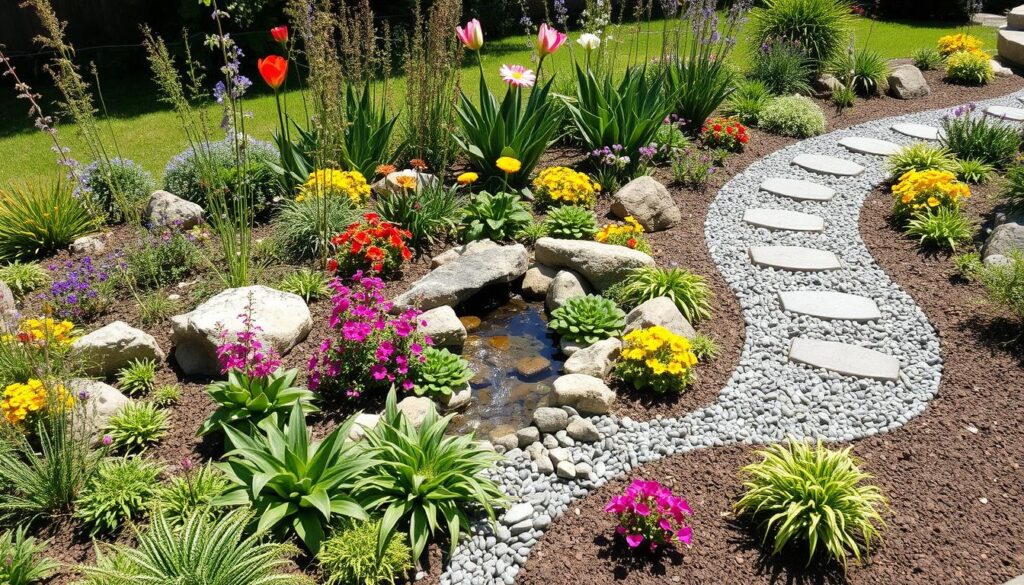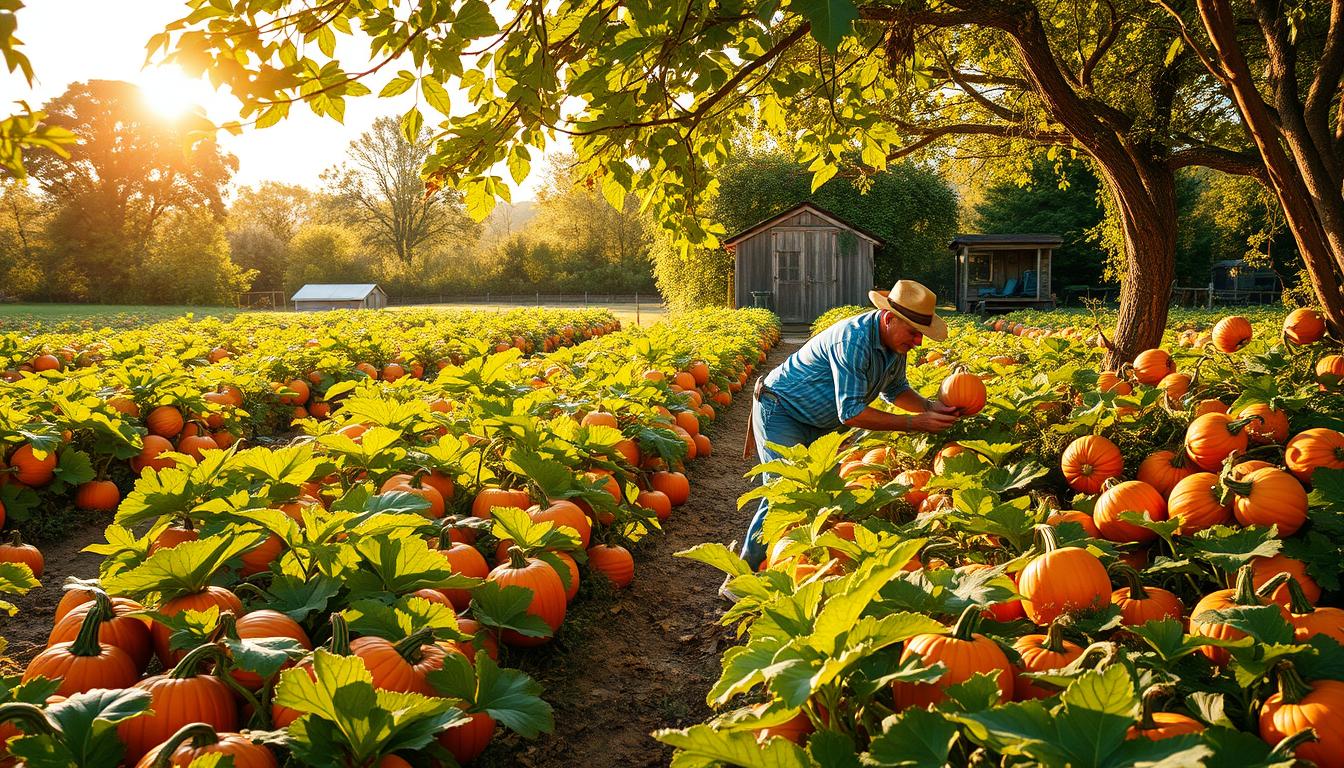In today’s world, we face many environmental challenges. Sustainable landscaping is key to solving these issues. Rain gardens are a new, effective solution. They help manage stormwater runoff and offer many benefits.
Rain gardens are shallow areas that catch and filter rainwater. They let it soak into the soil slowly. This helps reduce urban runoff and boosts groundwater recharge.
These gardens can be found in homes, businesses, or public areas. They act as mini reservoirs, catching water from rooftops and driveways. The soil and plants in the garden clean the water, keeping it from flowing into storm drains and harming local water bodies.
Key Takeaways
- Rain gardens are eco-friendly landscaping features that effectively manage stormwater runoff.
- They capture and filter rainwater, reducing the amount of pollutants entering local water bodies.
- Rain gardens promote groundwater recharge and support local biodiversity.
- Proper planning, including site selection, size calculation, and soil preparation, is crucial for a successful rain garden.
- Incorporating native plants and regular maintenance are essential for the long-term health and functionality of a rain garden.
Understanding Rain Gardens: Nature's Water Filter
Rain gardens are a special kind of landscaping that uses nature to solve big environmental problems. They are not like regular gardens. Rain gardens are made to hold and clean rainwater, catching pollutants and helping local watersheds.
What Makes Rain Gardens Different from Traditional Gardens
Rain gardens are all about helping the environment, not just looking good. They focus on letting water soak into the ground, unlike regular gardens. This way, they help keep our waterways clean by stopping stormwater from getting into sewers.
Key Components of an Effective Rain Garden
- Native plants that can thrive in both wet and dry conditions
- Well-draining soil that allows for efficient pollutant filtration and habitat restoration
- Strategic placement in low-lying areas to maximize the capture of urban runoff
How Rain Gardens Process Water Runoff
Rain gardens soak up extra water and let it slowly seep into the ground. The plants’ roots help water move through the soil faster. This reduces the risk of floods and helps refill underground water sources.
By using nature’s power, rain gardens are a smart way to manage stormwater. They play a key role in keeping our water clean and our environment healthy.
Rain Garden to Help the Environment: Benefits and Impact
Rain gardens are a smart and green way to help our planet. They are special areas that catch and clean stormwater runoff. This helps fight climate change and water pollution.
One big plus of rain gardens is how well they clean water. They can remove up to 80% of sediments and up to 90% of chemicals. This is more effective than a regular lawn. It keeps harmful stuff out of our water, making our environment healthier.
| Benefit | Percentage Improvement |
|---|---|
| Sediment Removal | 80% |
| Chemical Removal | 90% |
| Runoff Reduction | 30% |
Rain gardens also help reduce runoff and recharge groundwater. They can absorb up to 90% of stormwater from a home lot. This reduces flooding and erosion risks and helps our aquifers.
They also create great habitats for wildlife. By using native plants, they attract bees, butterflies, and other animals. This boosts local biodiversity and can even increase a home’s value by over $1,500.
Best of all, rain gardens are easy to care for. They don’t need mowing, watering, or harmful chemicals. This makes them a great choice for those wanting to reduce their environmental impact.
“Rain gardens are a simple yet powerful way for homeowners and communities to make a tangible difference in the fight against climate change and water pollution.”
In summary, rain gardens are a smart choice for our planet. They offer many benefits, from cleaning water to creating habitats. By using rain gardens, we can all help make our future more sustainable and resilient.

Designing Your Perfect Rain Garden Layout
Creating an eco-friendly rain garden requires careful planning. You need to pick the right spot, size, and depth. Each detail is important for environmental sustainability and urban runoff control.
Selecting the Ideal Location
Start by finding the best spot for your rain garden. Look for a place at least 10 feet from your home. It should be where water naturally flows. A slight slope is good, but not required.
By choosing the right location, you help with groundwater recharge and watershed protection.
Calculating the Right Size and Depth
- Rain gardens for homes are usually 100 to 300 square feet.
- They should be 4 to 8 inches deep for flood control and bioswale effectiveness.
- The garden should cover 10-30% of the drainage area to manage urban runoff well.
Soil Preparation and Drainage Considerations
Soil preparation is key for a successful rain garden. Add compost to improve soil structure and water absorption. Use organic mulch to keep soil moist, control weeds, and regulate temperature.
Make sure the garden drains well. It should empty within 24-48 hours after rain to avoid water stagnation and mosquito issues.

With these design tips, you can make a rain garden that’s beautiful and eco-friendly. It will enhance environmental protection and beautify your outdoor area.
Native Plants and Biodiversity in Rain Gardens
Rain gardens are a showcase for native plants. These plants are well-suited to local weather and soil. They help rain gardens work well by soaking up water and filtering out pollutants. They also support local wildlife, making rain gardens a key part of urban ecosystems.
When picking plants for your rain garden, think about the sun, soil, moisture, and how water flows. Choose a mix of native trees, shrubs, grasses, and flowers. This variety adds beauty and boosts the garden’s ecological value.
- Trees and shrubs like Betula nigra (River Birch), Cephalanthus occidentalis (Buttonbush), and Viburnum nudum (Possumhaw Viburnum) do well in wet areas.
- Middle zone plants such as Clethra alnifolia (Summersweet) and Itea virginica (Virginia Sweetspire) add depth and texture.
- The transition zone has plants that can handle dry spells, like Hamamelis virginiana (Witch Hazel) and Rhus aromatica (Fragrant Sumac).
Native plants make rain gardens look good and work well. They soak up water, filter pollutants, and support local wildlife. By choosing a variety of native plants, you can make a rain garden that’s good for the environment and your community.

“Rain gardens are a shining example of how ecological design can transform urban landscapes, providing multifunctional benefits that support sustainable drainage and enhance overall ecosystem services.”
Conclusion
Rain gardens are smart ways to manage water, offering many benefits. They cut down on water pollution, stop flooding, and make homes for local animals. By using rain gardens, we help the environment and get beautiful, easy-to-care-for gardens.
Rain gardens are part of a bigger effort to protect our communities from flooding, drought, and heat. They help us live better with nature, leading to a greener, stronger future.
By choosing rain gardens, we can all help the planet. More people, businesses, and cities using them means better water management. This way, we protect our water for years to come.
FAQ
Q: What are rain gardens?
A: Rain gardens are special spots in your yard that help manage rainwater. They are shallow areas that catch and filter rainwater. This lets the water soak into the soil slowly.
Q: How do rain gardens differ from traditional gardens?
A: Rain gardens hold rainwater and filter out pollutants. They drain within 24-48 hours after rain. Traditional gardens don’t do this.
Q: What are the key components of an effective rain garden?
A: An effective rain garden needs native plants that handle wet and dry. It also needs well-draining soil and a spot to catch runoff.
Q: How do rain gardens process water runoff?
A: Rain gardens soak up excess water, preventing flooding. The plants’ roots help water penetrate deeper and faster than in lawns.
Q: What are the environmental benefits of rain gardens?
A: Rain gardens reduce pollution, recharge groundwater, and prevent erosion. They can filter up to 90% of runoff, lowering flood risks.
Q: How do you design and prepare a rain garden?
A: Choose a spot 10 feet from buildings and where runoff naturally flows. Improve soil with compost. Make sure it drains in 24-48 hours.
Q: What types of plants are best for rain gardens?
A: Native plants are best for rain gardens. They fit local climate and soil, helping with water absorption and supporting biodiversity.






